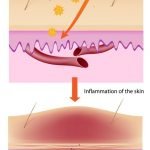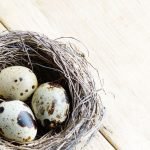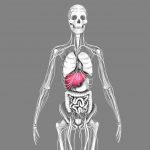IVF Integrative Fertility Support: Part 1
Masina Wright, ND
ART, or Assisted Reproductive Technology, has become mainstream medical practice. Many of our fertility patients will be women over 35 years of age, often already in the midst of #TTC (Trying To Conceive). Integrative medicine offers effective tools to enhance fertility and improve the chance of live pregnancy using all methods of conception including insemination and in-vitro fertilization (IVF). This article (Part 1) will review preconception and follicular-phase integrative medical support to enhance conception. Part 2 of this series will outline luteal phase-implantation support and early miscarriage prevention using naturopathic modalities.
Preconception
Ideally, a couple will come in 6 to12 months before being actively ready to start trying to conceive. For preconception support, maximize nutritional status, including activated folate, zinc, B vitamins, calcium, magnesium, and essential fats, including at least 450 mg DHA daily. Boosting superfoods and nutrient-dense foods are key nutritional strategies; however, be aware of excessive cold-damp smoothies, especially in northern climates.
For women who are not undergoing ultrasound cycle-monitoring, some understanding of fertility charting is crucial to accurately time ovulation and to maximize preconception fertilization opportunities. The best charting software that I have used is found at www.fertilityfriend.com. This is an online predictive resource that also has a mobile app for easy consumer use. Morning temperature charting is best done for at least 3 months in order to create a predictive ovulatory pattern; after a pattern is determined, daily temperature-taking does not need to be maintained other than during the follicular week, unless the patient desires to do so. This website includes 10 educational sessions on understanding charting, which creates a sense of empowerment and self-motivation for the couple looking to conceive.
Consider priming follicular reserves with an amino acid-based human growth hormone formula. Systemic inflammation and immune system dysregulation can be underlying factors that inhibit implantation, and may represent poorly-understood mechanisms in idiopathic infertility. Therefore, I include 200-food sensitivity testing that exposes not only IgG antibody pathways, but also T-cell and complement-driven inflammatory pathways activated by food antigens. I also typically recommend at least a 2-week Candida cleanse, as yeast tends to accumulate in the female reproductive system.
Additionally, I recommend daily Mayan fertility massage and TCM acupressure points with daily castor oil packs to release local tension, tonify key reproductive channels, stimulate bowel function, clear lymphatic congestion, and increase blood flow to the uterus and ovaries.1 This practice has the additional benefit of connecting patients to their physical bodies and engaging viscerally in what can be a cerebral process of conception.
Follicle-stimulating hormone (FSH) levels must be tested on Day 3 of the menstrual cycle, along with anti-Müllerian hormone (AMH) levels before beginning fertility protocols. FSH reflects the relationship between the ovaries and pituitary, and higher levels indicate perimenopause and poor ovarian function. AMH has also been called the “egg timer,” as it gives an accurate level of the follicular reserves of the ovaries. AMH levels do not fluctuate throughout a cycle and can be tested at any time. Serum AMH levels decline throughout one’s reproductive life-cycle and are undetectable after menopause; therefore, higher levels are more desirable. Other blood work that should be assessed on Days 19-21 include:
- DHEA-S
- Progesterone
- Full estrogen panel, including Estradiol and Estrone
- Testosterone
- Free testosterone
- Sex-hormone binding globulin (SHBG)
- Homocysteine
- HbA1C
- Fasting insulin
- Fasting blood glucose
- Blood lipids
- Complete thyroid panel including Free T3 and thyroid autoantibodies
All hormones should be optimized using bioidentical hormones, if possible. ART doctors will manipulate estrogen and progesterone levels. It is important to also address total and free testosterone, DHEA-S, and thyroid levels including Free T3, as these all impact potential fertility. Other possible tests that could be of value for difficult infertility cases include a full-month salivary hormone cycle assessment, salivary melatonin levels, 4-point salivary cortisol levels, a neurotransmitter panel, and a vaginal dysbiosis culture.
At least 40% of people are lacking the gene to activate folic acid.2 Having one of these MTHFR polymorphisms can result in higher miscarriage rates.2 Testing for genetic methylation defects is key in patients with a family history of miscarriage, endometriosis, a long history of oral contraceptive use, history of miscarriage or chemical pregnancies, or in patients presenting with other signs of folic acid deficiency or methylation defects, including elevated homocysteine. Recent evidence has linked a higher incidence of Autism Spectrum Disorder in children born to women with folic acid deficiency.3Current guidelines require clinicians to rule out possible pernicious anemia, a 3-generation review of family history for neural tube defects, and a medication review to assess for pharmaceutically-induced folate depletion when determining the appropriate level of prenatal supplementation.4,5 Dosage of 5-MTHF (activated folate) ranges from 0.8 to 5 mg daily.
Follicular Phase Support
Getting pregnant involves 2 main steps: 1) the follicular phase, focused on optimizing egg development; and 2) the luteal phase, focused on uterine lining and implantation. In IVF, the follicular phase is usually a single round with the goal of an optimal egg harvest. Viable eggs are fertilized and embryos are cryo-preserved for transfer. The transfer phase of IVF can involve successive rounds, depending on the number of embryos generated.
The oocytes are one of the few bodily tissues that the body does not constantly regenerate; women are born with the eggs they will have for their lifetime. However, oocytes can be protected, supercharged, and manipulated for higher fertility using botanicals, nutraceuticals, acupuncture, and possibly pharmaceuticals. Clomiphene citrate is often used to stimulate an egg cascade in all fertility protocols, and will deplete jing and yin. Ho Show Wu and yin-tonifying diet, yoga, and acupuncture should accompany all clomiphene citrate and other follicle-stimulating protocols.6
There has been considerable research on acupuncture and ART. It has been evidenced that clinical outcomes are improved by doing acupuncture treatments flanking the egg retrieval and embryo transfer process in IVF. The points used in the studies during ovarian stimulation include: ST 36, SP 6, LV 3, LI 4, KI 3, GV 20, and Zi Gong (Extra 18).7
Jane Lyttleton is the matriarch of TCM fertility care and authored one of the foundational texts for this work. She has formulated a line of Chinese botanical formulations specifically designed for the IVF cycle to complement the medication and treatment protocols administered by fertility clinics. I also use these in patients who are not doing IVF, to nourish and rectify the blood/yin/yang aspects of the menstrual cycle. Generically, they can each be used for 7 days during a 28-day cycle, with Day 1 being the first day of bleeding; however, I tailor them to the individual ovulatory patterns. Further training on TCM and fertility enhancement is available through Pro-D seminars (http://www.prodseminars.net/).
Patients with moderately-high FSH (15 or less) can benefit from constitutional acupuncture, stress management, and botanical support for the pituitary–ovarian–adrenal axis. Vitex agnus-castus is a key player, as it facilitates the communication between ovaries and pituitary; however, jing tonic herbs like Ho Show Wu, and adrenal restorative botanicals like Eleutherococcus (which is safe in pregnancy) are good adjunctive agents as well. Melatonin is also a supportive therapy, with dosages ranging from 0.3 to 10 mg, depending on the individual.
Patients with low AMH will need tonics and acupuncture to specifically nurture jing and yin. Technically, levels cannot be restored, but they can be maintained. CoQ10 and DHEA supplementation will be crucial with this population.
CoQ10 and DHEA
CoQ10 is imperative to egg health. Egg division from 46 to 23 chromosomes requires effective mitochondrial function.8 It has been suggested that mitochondrial DNA defects that affect metabolic capacity may be a proximal cause of failures in oocyte maturation, fertilization, or early embryonic development.9 Aged eggs have decreased mitochondrial energy, which can result in deficient energy to divide properly, resulting in Down syndrome and other genetic anomalies. All women over the age of 30 who are still considering pregnancy should be on 100 mg of ubiquonol (CoQ10) daily to maintain efficient mitochondrial activity.
Dr Robert Casper and Dr Andrea Jurisicova are doing research on CoQ10 and oocyte mitochondrial function in Toronto, Ontario. Pilot studies have shown that mice treated with CoQ10 had improved oocyte mitochondrial function. “By studying the quality of oocytes (in an animal model) in older versus younger mothers, the duo have found that mitochondria, the energy-producing power stations of cells, become less metabolically active with age, putting the offspring at greater risk of developing obesity and metabolic syndrome, and predisposing them to diabetes. However, administration of coenzyme Q10—a vitamin-like substance found in mitochondria—can reverse the effects of mitochondrial changes in oocytes, improve fertility, and perhaps reduce the risk of chromosomal abnormalities.”10
DHEA is also a key player in oocyte health, leading to improved embryo quality and higher live birth rates compared to controls. Studies have used 75 mg of DHEA daily.11 In a study of long-term poor responders to IVF, DHEA supplementation at a dose of 25 mg TID promoted higher rates of spontaneous pregnancies.12 DHEA is an androgenic hormone released by the adrenal glands that can act as an endocrine precursor to other hormones. Androgenization increases the response to follicle-stimulating medications, resulting in improved egg yields.13 DHEA supplementation also slows the aging process via antioxidant action by preventing lipid peroxidation while improving energy and metabolism.14
Egg-Dominated (Follicular Phase) IVG
The first phase of IVF treatment consists of ovarian hyperstimulation to produce multiple ovarian follicles and a high oocyte yield for fertilization. Current regimens for ovarian stimulation in IVF are complex, with some requiring several weeks of daily medication injections. This process is expensive and time-consuming, as frequent ovarian response-monitoring is required to ensure patient safety and optimal treatment outcomes. Follicular stimulation is done using either human menopausal gonadotropins (hMGs) or FSH.15 These daily gonadotropin injections for up to 2 weeks often contribute to high levels of stress and anxiety for the patient; therefore, stress management is imperative.
Gonadotropin-releasing hormone (GnRh) antagonists can be used to prevent an endogenous luteinizing hormone (LH) surge during controlled ovarian hyperstimulation. By competing with GnRh at the receptor level, gonadotropin secretion is arrested. The protocol for GnRh antagonism depends on the appearance of menses. Pretreating with oral contraceptives has been recommended for streamlining the IVF process, simplifying scheduling for oocyte retrieval, and for patient and doctor convenience.15
In an IVF treatment cycle, urinary and recombinant hCG has been used to mimic the endogenous LH surge. GnRh agonists may also be used. This LH surge is essential in the final stages of oocyte maturation and for triggering follicle rupture, with expulsion of the oocyte from the ovarian follicle. In addition, the LH surge promotes luteinization to form an active corpus luteum.15
Ovarian Hyperstimulation Syndrome (OHSS) is a potentially serious, usually self-limited condition that can affect up to 35% of women undergoing IVF.16 It is more likely to occur in women with PCOS with multiple follicle development, and with very high levels of estrogen. There are 5 grades of OHSS, with 25% of women having Grade 1 symptoms that include a tense abdomen and abdominal distention and pain.16 The peri-ovarian blood vessels become functionally impaired as a result of LH/hCG hormonal stimulation, resulting in protein-rich fluid leaking into the abdominal space and an osmolar shift. Second-stage symptoms include nausea, diarrhea, vomiting, and ovarian cyst formation of up to 5-25 cm. As the grades increase up to 5, ascites, hydrothorax, changes in blood volume, hypercoagulation, and ultimately decreased renal and cardiac output can develop. Women are recommended to record their weight daily, as an increase of 5+ lbs/wk or 2+ lbs/day are cause for concern and may require hospitalization. Among women in Stage 5 OHSS, 92% will have shortness of breath, thus dyspnea can also be an important hallmark of progressive pathology.16
Treatment is aimed at the correction of fluid and electrolyte imbalances, and involves adequate hydration, rest, and avoiding intercourse or strenuous activity that could result in cyst rupture. Classically, a commercial electrolyte beverage is suggested; however, sodium resorption is already increased, with a resultant potassium ion accumulation leading to acidosis. I prefer using coconut water or electrolyte replacement powders that are low in sugar and sodium for balancing electrolytes. Other therapeutics to shift the body to a more alkaline state would also be indicated. High-dose EPA could also be used to reduce coagulability. Parenteral therapy would also be appropriate for naturopathic physicians trained in this modality.
Summary
In conclusion, the follicular phase of conception is focused on nourishing and optimizing egg health. Balancing microbiology, optimizing hormones, supercharging nutrient status, and clearing underlying inflammatory pathologies are important preconception steps. CoQ10 (100-400 mg QD) along with DHEA (25 mg TID) is a core treatment strategy to protect and rejuvenate mature oocytes. The follicular half of the cycle is the yin phase; the underlying philosophy must be to nurture, restore, and regenerate to maximize ovulation or ovarian stimulation for IVF cycles, for the purpose of healthy blastocyst development.
View IVF Integrative Fertility Support Part 2 | Coming Sept 2014
 Masina Wright, ND, is an expert in regenerative and restorative health. She provides consultation and treatment in fertility, hormonal health, and anti-aging medicine, with a focus on transgender/transsexual and women’s health. Dr. Wright is a leader in the field of integrative medicine. Trained to understand the intricacies of modern health, she is sophisticated and yet intuitive, cutting edge and yet traditional. She practices in Portland, Maine and also offers Skype consults to patients around the globe. Follow her on Twitter @thewrightdoctor and on Facebook at www.facebook.com/thewrightdoctor.
Masina Wright, ND, is an expert in regenerative and restorative health. She provides consultation and treatment in fertility, hormonal health, and anti-aging medicine, with a focus on transgender/transsexual and women’s health. Dr. Wright is a leader in the field of integrative medicine. Trained to understand the intricacies of modern health, she is sophisticated and yet intuitive, cutting edge and yet traditional. She practices in Portland, Maine and also offers Skype consults to patients around the globe. Follow her on Twitter @thewrightdoctor and on Facebook at www.facebook.com/thewrightdoctor.
References
- Natural Fertility Info. http://natural-fertility-info.com/natural-fertility-expert. Accessed February 15, 2014.
- Folic Acid supplementation andpregnancy: more than just neuraltube defect prevention. Greenberg JA, Bell SJ, Guan Y, Yu YH. Rev Obstet Gynecol. 2011;4(2):52-59.
- Medscape Pediatrics. Basco WT. Autism and Folic Acid in Pregnancy. Medscape Web site. http://www.medscape.com/viewarticle/803341. Accessed March 22, 2014.
- Wilson RD, Davies G, Désilets V, et al. The use of folic acid for the prevention of neural tube defects and other congenital anomalies. J Obstet Gynaecol Can. 2003;25(11):959-973.
- Koren G, Goh YI, Klieger C. Folic Acid. November, 2008. MotherRisk Web site. http://www.motherisk.org/women/updatesDetail.jsp?content_id=891. Accessed March 22, 2014.
- Jane Lyttleton, BSc. Treatment of Infertility with Chinese Medicine. Seminar presented May 2007; Toronto, Ontario.
- Liang L. Acupuncture & IVF: Increase IVF Success by 40-60%. Boulder, CO: Blue Poppy Press; 2003.
- Meldrum DR. Aging gonads, glands, and gametes: immutable or partially reversible changes? Fertil Steril. 2013;99(1):1-4.
- Bentov Y, Esfandiari N, Burstein E, Casper RF. The use of mitochondrial nutrients to improve the outcome of infertility treatment in older patients. Fertil Steril. 2010;93(1):272-275.
- Mount Sinai duo uncovering the molecular events underlying infertility. Mount Sinai Hospital. Lunenfeld-Tanenbaum Research Institute Web site. http://research.lunenfeld.ca/rss/Default.asp?page=1950. Accessed February 15, 2014.
- Wiser A, Gonen O, Ghetler Y, et al. Addition of dehydroepiandrosterone (DHEA) for poor-responder patients before and during IVF treatment improves the pregnancy rate: a randomized prospective study. Hum Reprod. 2010;25(10):2496-2500.
- Mamas L, Mamas E. Dehydroepiandrosterone supplementation in assisted reproduction: rationale and results. Curr Opin Obstet Gynecol. 2009;21(4):306-308.
- Moawad A, Shaeer M. Long-term androgen priming by use of dehydroepiandrosterone (DHEA) improves IVF outcome in poor-responder patients. A randomized controlled study. Middle East Fertil Soc J. 2012;17(4):168-274. Available at: http://www.sciencedirect.com/science/article/pii/S1110569012001124. Accessed March 5, 2014.
- Rouzier M. Mastering the Protocols for Optimization of Hormone Replacement Therapy: 2013 Medical Seminar Series – Session 1. July 13, 2013; Chicago, IL.
- Ng C, Trew G. Endocrinological Insights Into Different in vitro Fertilization Treatment Aspects. Expert Review of Endocrinology and Metabolism. Medscape Web site. http://www.medscape.org/viewarticle/767900. Accessed March 5, 2014.
- Lucidi RS. Ovarian Hyperstimulation Syndrome. Medscape Web site. http://emedicine.medscape.com/article/1343572-overview. Accessed March 22, 2014.









